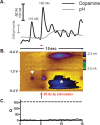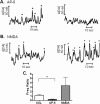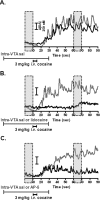Synaptic overflow of dopamine in the nucleus accumbens arises from neuronal activity in the ventral tegmental area
- PMID: 19211880
- PMCID: PMC2673986
- DOI: 10.1523/JNEUROSCI.5562-08.2009
Synaptic overflow of dopamine in the nucleus accumbens arises from neuronal activity in the ventral tegmental area
Abstract
Dopamine concentrations fluctuate on a subsecond time scale in the nucleus accumbens (NAc) of awake rats. These transients occur in resting animals, are more frequent following administration of drugs of abuse, and become time-locked to cues predicting reward. Despite their importance in various behaviors, the origin of these signals has not been demonstrated. Here we show that dopamine transients are evoked by neural activity in the ventral tegmental area (VTA), a brain region containing dopaminergic cell bodies. The frequency of naturally occurring dopamine transients in a resting, awake animal was reduced by a local VTA microinfusion of either lidocaine or (+/-)2-amino,5-phosphopentanoic acid (AP-5), an NMDA receptor antagonist that attenuates phasic firing. When dopamine increases were pharmacologically evoked by noncontingent administration of cocaine, intra-VTA infusion of lidocaine or AP-5 significantly diminished this effect. Dopamine transients acquired in response to a cue during intracranial self-stimulation were also attenuated by intra-VTA microinfusion of AP-5, and this was accompanied by an increase in latency to lever press. The results from these three distinct experiments directly demonstrate, for the first time, how neuronal firing of dopamine neurons originating in the VTA translates into synaptic overflow in a key terminal region, the NAc shell.
Figures






References
-
- Anderson RM, Fatigati MD, Rompré PP. Estimates of the axonal refractory period of midbrain dopamine neurons: their relevance to brain stimulation reward. Brain Res. 1996;718:83–88. - PubMed
-
- Arbuthnott GW, Wickens J. Space, time and dopamine. Trends Neurosci. 2007;30:62–69. - PubMed
-
- Bunney EB, Appel SB, Brodie MS. Electrophysiological effects of cocaethylene, cocaine, and ethanol on dopaminergic neurons of the ventral tegmental area. J Pharmacol Exp Ther. 2001;297:696–703. - PubMed
Publication types
MeSH terms
Substances
Grants and funding
LinkOut - more resources
Full Text Sources
Other Literature Sources
